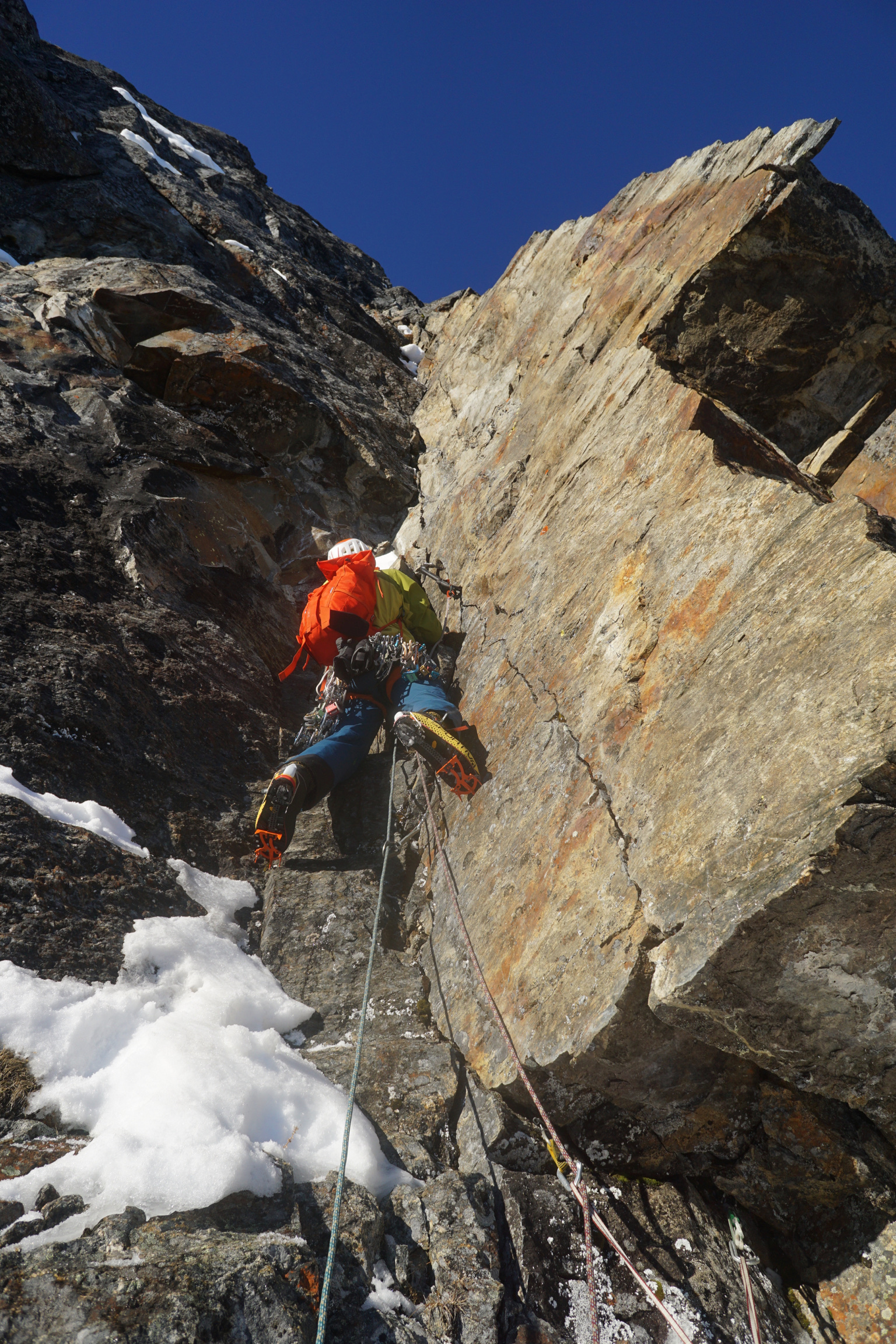Slesse Mountain, Navigator Wall, First Winter Ascent; Labour Day Buttress and Station D, First Winter Ascents and New Route
Canada, British Columbia, North Cascades
|
| The Slesse group from the east, showing (A) Labour Day Horn, (B) Station D, (C) South Peak, and (D) Slesse Mountain. (1) Approximate line of Navigator Wall. (2) Approximate line of 2017 free variation to the east face of Slesse. Photo by Steph Abegg |
Slesse is a sharp fang with impressive north and east faces. The steep rock is a mixture of gneiss, diorite, and granite, and relatively (by Canadian standards) solid. Very few routes climb these walls, and there’s an almost mythical, mystical air about Slesse, despite its low altitude (ca 2,400m). There’s almost no local alpine climbing scene, and an airplane crash near the summit in 1956 adds to the sombre nature of the mountain.
After my friend Uisdean Hawthorn and I climbed Mt. Alberta in 2016, Marc-André Leclerc told us about a winter project he had been dreaming of on Slesse. “Dudes, it’s awesome! It’s never had a winter ascent, I reckon there’s a new line! It’s so steep, I think you’d need a portaledge,” he told us. After Tony McLane and Jacob Cook made the first free ascent of Slesse’s East Face last summer, I messaged Marc and said I was keen to try his winter project (although I have no recollection of this). Soon I was booking flights to Canada.
 When I arrived at the start of January 2018, the forecast showed a couple days of good weather and Marc was psyched—a theme which would continue throughout my trip. In the haze of jet lag, I agreed to all plans, and suddenly was surrounded by stoked Canadians, skiing up to Slesse. Marc had organized a helicopter to fly supplies to our “base camp,” thus allowing us to utilize the good weather for climbing rather than load carrying. Brette Harrington, Marc’s girlfriend, and Kieran Brownie joined us, and my foggy mind cleared as we climbed higher into the alpine. We left the dense trees below, the mountain scene opening like a stage. I breathed fresh air deep into my lungs.
When I arrived at the start of January 2018, the forecast showed a couple days of good weather and Marc was psyched—a theme which would continue throughout my trip. In the haze of jet lag, I agreed to all plans, and suddenly was surrounded by stoked Canadians, skiing up to Slesse. Marc had organized a helicopter to fly supplies to our “base camp,” thus allowing us to utilize the good weather for climbing rather than load carrying. Brette Harrington, Marc’s girlfriend, and Kieran Brownie joined us, and my foggy mind cleared as we climbed higher into the alpine. We left the dense trees below, the mountain scene opening like a stage. I breathed fresh air deep into my lungs.
Marc’s “Mega Proj” wasn’t fully formed—ice is required in the lower third. And so we settled for a consolation prize: the first winter ascent of Slesse’s Navigator Wall (700m, 6b M7+ R; the climb is rated ED1 5.10+ in summer). Marc had free soloed the route in 2014 during a linkup of three big solo routes on Slesse in one day. The climbing was on predominantly good rock and was either dry-tooling, mixed, or ice. There were some steep corners, icy slabs, rocky overhangs, and everything in between. In some places, we had to climb with bare hands and crampons. The wall was in the sunshine for about an hour in the morning, but then went into the shade. This made the bare-hands climbing quite problematic at times.
Marc and I climbed well together, and his knowledge of Navigator Wall (and Slesse in general) was very helpful. A couple of harder pitches in the M7/ Scottish VIII/IX region proved interesting. The rock was at times suboptimal, and there were some quite serious runouts too. There was also a bunch of Scottish tech VII. We skipped the final two headwall pitches of Marc’s summer climb as it was dark, and we only wanted a warm-up experience. Instead we decided to follow the scrambly terrain up and left, which seemed more logical.
– Tom Livingstone, U.K.
Labour Day Buttress and Station D, First Winter Ascents and New Route: While Leclerc and Livingstone were climbing Navigator Wall on Slesse Mountain, Kieran Brownie and Brette Harrington linked two first winter ascents. They first climbed Labour Day Buttress (III, D- 5.7/5.8), which is the northeast buttress of Labour Day Horn, the peak at the south end of the Slesse massif, and then traversed to the east ridge of Station D (Peak 5), which they climbed by the east face, just right of the ridge, making the first winter ascent of the peak. During a three-day trip in February 2018, Harrington, accompanied by Leclerc, led the first ascent of Jupiter Shift (200m, M5+ 85°), a striking gash on the north face of Station D.






